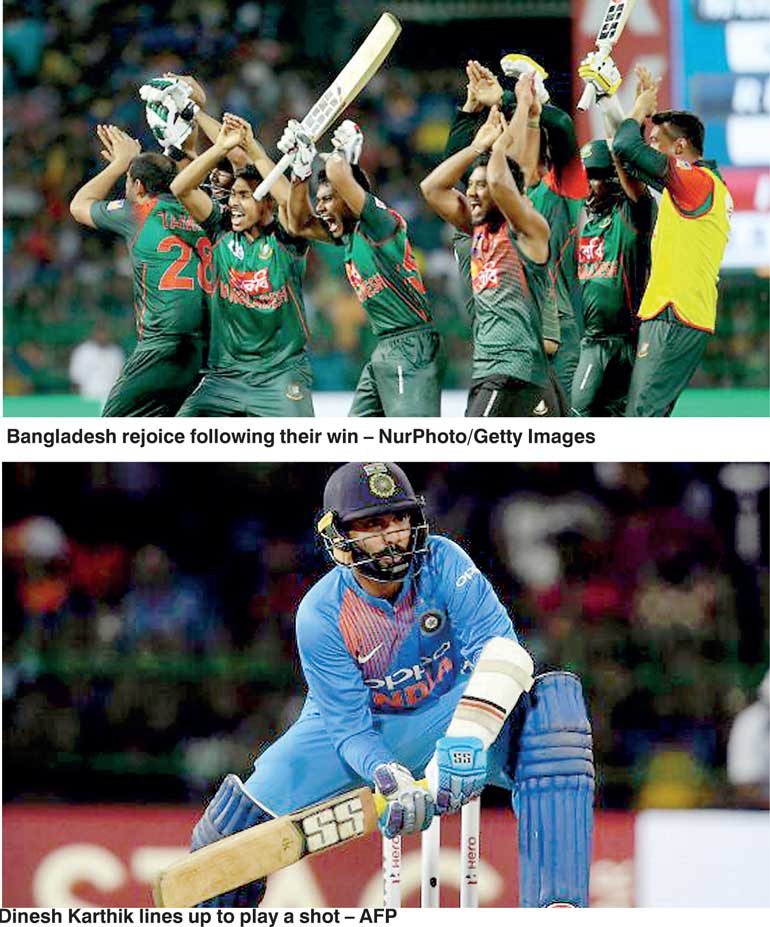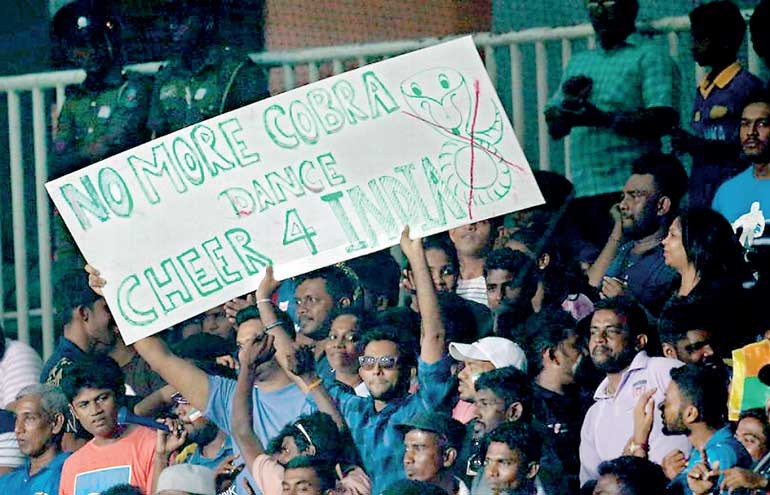Wednesday Mar 05, 2025
Wednesday Mar 05, 2025
Wednesday, 21 March 2018 01:41 - - {{hitsCtrl.values.hits}}
Tri-series may be the future of T20Is

ESPNCricinfo: The final of the Nidahas Trophy was played before a loud crowd, with the stadium at least two-thirds full despite the absence of the home team, Sri Lanka. A common fear for countries hosting tri-series is that games between neutral teams will be a hard sell.
The atmosphere at the R. Premadasa was, in part, fuelled by a resentment among the Sri Lanka supporters of the Bangladesh team, after an exuberant celebration at the conclusion of an ill-tempered final league game, an effective knockout tie against Sri Lanka. Most of the home fans cheered for India in the final. But the attendance was also proof that a final will always be a draw for viewers and will give legs to the idea that tri-series are the future of T20 internationals.
Don’t need big names for big excitement
One of the hurdles in organising a tri-series is that it is hard to find spaces in the crowded cricket calendar for three teams. Indeed, the Nidahas Trophy came at an awkward time for India. They had completed a long tour of South Africa just 10 days before the start of the tournament with the Indian Premier League a little more than two weeks after the final.
They rested several of their biggest names, including Virat Kohli, MS Dhoni, Bhuvneshwar Kumar and Jasprit Bumrah, leading to a subdued build up to the tournament in India. In Tests or 50-over cricket, an absence of so many key players may have adversely affected the quality of cricket on show, but with the number of T20 specialists countries now seem to have, it is not as much of an issue in the format.
That the Nidahas Trophy provided the entertainment it did will, perhaps, encourage boards to schedule T20I tri-series even during periods when they know teams may rest some of their players.

What will Dinesh Karthik’s innings mean for MS Dhoni?
Over the past year or so, MS Dhoni’s position in India’s side has been a subject of discussion. Dhoni has not been able to score as quickly as he once did, and, besides, there is no World T20 scheduled before 2020, by when Dhoni will be 39.
Dhoni hit 52 off 28 balls in the second T20I in South Africa, temporarily killing the debate, but the decision to rest him from the Nidahas Trophy gave Dinesh Karthik an opportunity to show the value he can bring to the Indian side. He took India home twice, once with an unbeaten 39 in a league game against Sri Lanka and then in spectacular fashion in the final, perhaps reigniting thoughts of phasing Dhoni out of T20Is.
Has Washington Sundar proved fingerspin has a place in T20s?
Of the top 15 T20I bowlers in the ICC rankings, seven are wristspinners. The accepted theory is that wristspinners, with their variations and unpredictability, are more likely to make the batsmen fail at execution. But the performances of Washington Sundar may have given India a selection headache. He conceded at less than six an over through the tournament and took eight wickets, earning the Man-of-the-Series award. And he managed this while bowling 13 of his 20 overs in the Powerplay.
What stood out about Sundar was his ability to read when batsmen were going to attempt the big shot and then deceive them by changing up the pace or line. At just 18, he has announced himself as perhaps India’s best fingerspinning option in the limited-overs formats.
Ghost of 2016 is exorcised and then returns to haunt Bangladesh
Almost two years ago, Mushfiqur Rahim and Mahmudullah were guilty of celebrating too early as Bangladesh drew within one run of India’s score in a crunch World T20 match in Bengaluru, only to lose three wickets in three balls and crash out of the tournament.
In the Nidahas Trophy, Bangladesh were faced with three more tense endings. In the first, Rahim held his nerve against Sri Lanka to take his side home with two balls to spare. In the second, Mahmudullah kept his cool through arguments and his captain threatening to pull his batsmen off the field, to hit a six off the game’s penultimate ball. But in the final, against India, Bangladesh once again squandered a winning position, leaking 34 runs off the last two overs. It seems India still have the psychological edge over them in the death.
Are the ICC being consistent in handing out demerit points?
The demerit point tally in the ongoing South Africa-Australia Test series has nearly reached double digits, after several incidents, including one between David Warner and Quinton de Kock. But after the effective knockout match between Sri Lanka and Bangladesh in the Nidahas Trophy nearly descended into a brawl, just two players, Shakib Al Hasan and Nurul Hasan, have been pulled up and given a demerit point each.
In the final over of Bangladesh’s chase, an umpiring error led Mahmudullah to begin remonstrating with the umpire. Meanwhile, Nurul, a substitute was shoved by Upul Tharanga during an argument with Thisara Perera. Shakib, the Bangladesh captain, charged down from the dressing room and threatened to forfeit the game. There were more heated arguments, and a door in the Bangladesh dressing room was found shattered later.
Making physical contact with an opponent, excessive celebration, showing dissent for umpires’ decisions and even just using aggressive language on the field are all transgressions that have elicited demerit points in other international games, but several instances of those transgressions seem to have been ignored in this case.
Given that the entire fracas stemmed from an umpiring error – the umpire did not call the first bouncer of the over and hence could not deem the second a no-ball – the ICC may consider assigning at least two umpires from the Elite panel to T20Is, as they do for ODIs.
 \
\
The local crowd showed one-sided support for the Indian team – NurPhoto/Getty Images
Discover Kapruka, the leading online shopping platform in Sri Lanka, where you can conveniently send Gifts and Flowers to your loved ones for any event including Valentine ’s Day. Explore a wide range of popular Shopping Categories on Kapruka, including Toys, Groceries, Electronics, Birthday Cakes, Fruits, Chocolates, Flower Bouquets, Clothing, Watches, Lingerie, Gift Sets and Jewellery. Also if you’re interested in selling with Kapruka, Partner Central by Kapruka is the best solution to start with. Moreover, through Kapruka Global Shop, you can also enjoy the convenience of purchasing products from renowned platforms like Amazon and eBay and have them delivered to Sri Lanka.
Discover Kapruka, the leading online shopping platform in Sri Lanka, where you can conveniently send Gifts and Flowers to your loved ones for any event including Valentine ’s Day. Explore a wide range of popular Shopping Categories on Kapruka, including Toys, Groceries, Electronics, Birthday Cakes, Fruits, Chocolates, Flower Bouquets, Clothing, Watches, Lingerie, Gift Sets and Jewellery. Also if you’re interested in selling with Kapruka, Partner Central by Kapruka is the best solution to start with. Moreover, through Kapruka Global Shop, you can also enjoy the convenience of purchasing products from renowned platforms like Amazon and eBay and have them delivered to Sri Lanka.